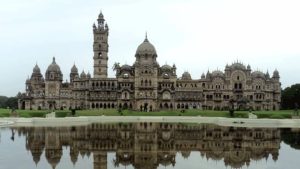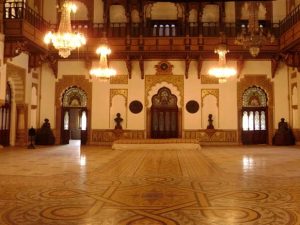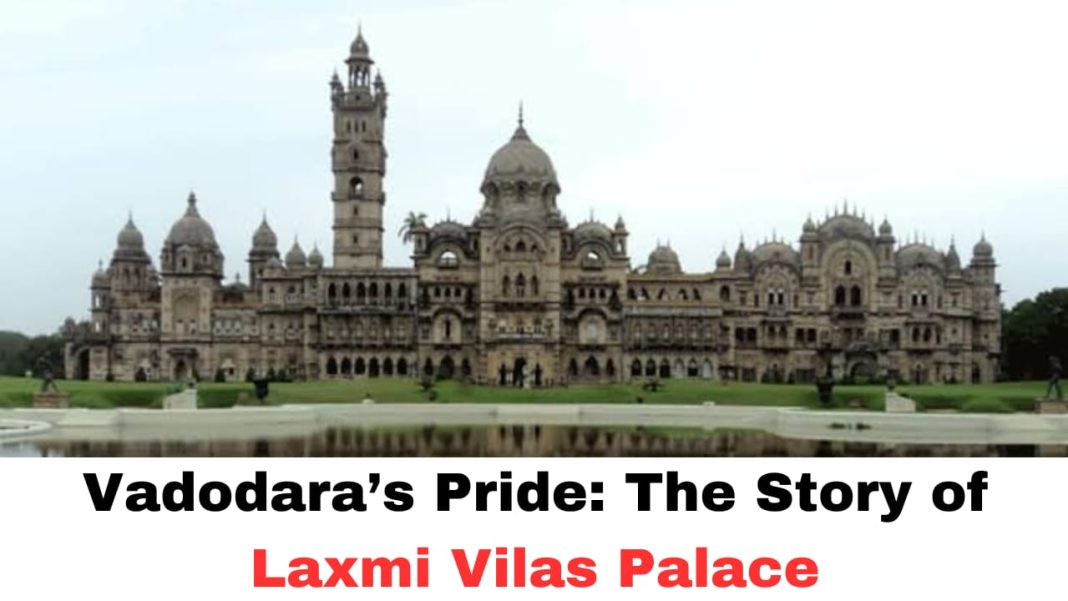Digital News Guru Gujarat Desk:
Laxmi Vilas Palace, Vadodara: A Majestic Symbol of Royal Grandeur
The Laxmi Vilas Palace, located in Vadodara, Gujarat, stands as an architectural marvel and a testament to India’s regal past. Built in the 19th century, the palace is a blend of Indo-Saracenic and European architectural styles, reflecting the opulence and vision of the Gaekwad dynasty. Today, it remains a popular tourist attraction, drawing visitors from across the globe to marvel at its grandeur, rich history, and cultural significance.
A Glimpse into History
The Laxmi Vilas Palace was commissioned by Maharaja Sayajirao Gaekwad III in 1890. The Gaekwad dynasty, known for its progressive and reformist policies, envisioned the palace as not just a residence but also a symbol of their power and prestige.

The palace was designed by Major Charles Mant, an English architect renowned for his eclectic architectural style. The construction of the palace took over 12 years and was completed at a staggering cost of Rs 27 lakh at the time, an enormous amount for the late 19th century.
The name “Laxmi Vilas” honors Goddess Laxmi, the Hindu deity of wealth, prosperity, and well-being, emphasizing the royal family’s cultural and spiritual beliefs.
Architectural Splendor
The Laxmi Vilas Palace is widely regarded as one of the largest private residences in the world. It is nearly four times the size of Buckingham Palace in London, covering an expansive area of over 700 acres. The palace combines elements of Hindu, Mughal, and Gothic architecture, creating a visual spectacle that is both intricate and harmonious.
The façade of the palace is characterized by its grand domes, arches, and turrets, exuding an air of imperial elegance. The interiors are equally breathtaking, adorned with mosaics, chandeliers, Italian marble flooring, and Venetian glasswork. The palace also boasts a series of Belgian stained-glass windows and intricately carved wooden structures, showcasing exceptional craftsmanship.

One of the most remarkable features of the palace is its Darbar Hall, an opulent space with a Venetian mosaic floor, stained glass windows, and a high ceiling supported by ornate columns. This hall was used for royal ceremonies and important gatherings, epitomizing the grandeur of the Gaekwad dynasty.
The Royal Family’s Legacy
The Laxmi Vilas Palace continues to be the residence of the Gaekwad family, one of the most prominent royal families in India. While parts of the palace remain private, certain areas are open to the public, offering visitors a glimpse into royal life.
The Gaekwads were known not just for their wealth but also for their contributions to society. Maharaja Sayajirao Gaekwad III was a visionary ruler who implemented several reforms in education, women’s empowerment, and urban development. He is also credited with establishing Baroda College, now known as the Maharaja Sayajirao University of Baroda, one of the leading educational institutions in Gujarat.
Attractions within the Palace Grounds
- The Palace Museum:
A section of the palace has been converted into a museum that houses artifacts, paintings, and historical memorabilia from the Gaekwad dynasty. The museum is home to a remarkable collection of works by Raja Ravi Varma, a celebrated Indian artist known for his mythological paintings. - The Moti Baug Palace and Zoo:
The sprawling grounds of Laxmi Vilas Palace include the Moti Baug Palace, which now serves as a cultural and recreational center. The grounds also feature a zoo that was originally established to house exotic animals. - The Golf Course:
The 10-hole golf course within the palace complex is a unique attraction, blending the regal charm of the estate with a modern recreational facility. Visitors can play amidst lush greenery, surrounded by the palace’s architectural grandeur. - The Maharaja Fateh Singh Museum:
Located within the palace grounds, this museum showcases a wide array of art, including European paintings, sculptures, and other artifacts collected by the royal family over the years.
Cultural Significance
The Laxmi Vilas Palace is more than just an architectural wonder; it is a cultural hub that hosts a variety of events, exhibitions, and festivals. The palace has become a venue for royal weddings, concerts, and film shoots, blending its historical essence with contemporary appeal.
The Gaekwad dynasty’s patronage of arts and culture is evident in the palace’s design and the artifacts it houses. The royal family’s commitment to preserving their heritage ensures that the palace remains a vital link to India’s past.

Visiting Laxmi Vilas Palace
For tourists, the Laxmi Vilas Palace offers a journey through history and luxury. The palace is open to the public on all days except Mondays, and guided tours are available to help visitors explore its vast grounds and intricate details.
The entry ticket often includes access to the museum and the golf course, allowing guests to immerse themselves in the grandeur of the Gaekwad legacy. Audio guides in multiple languages are also provided to enhance the visitor experience.
Conclusion
The Laxmi Vilas Palace is not just a monument; it is a living testament to India’s rich royal heritage. Its architectural brilliance, historical importance, and cultural contributions make it a must-visit destination for history enthusiasts and tourists alike.
Whether you are drawn by its majestic architecture, its artistic treasures, or its serene surroundings, the Laxmi Vilas Palace offers an unforgettable experience. It stands as a proud symbol of Vadodara’s royal past and a beacon of India’s enduring legacy of grandeur and sophistication.
You May Also Read: The Wait is Over: ‘Paatal Lok’ Season 2 Ready to Premieres on Prime Video on January 17, 2025








